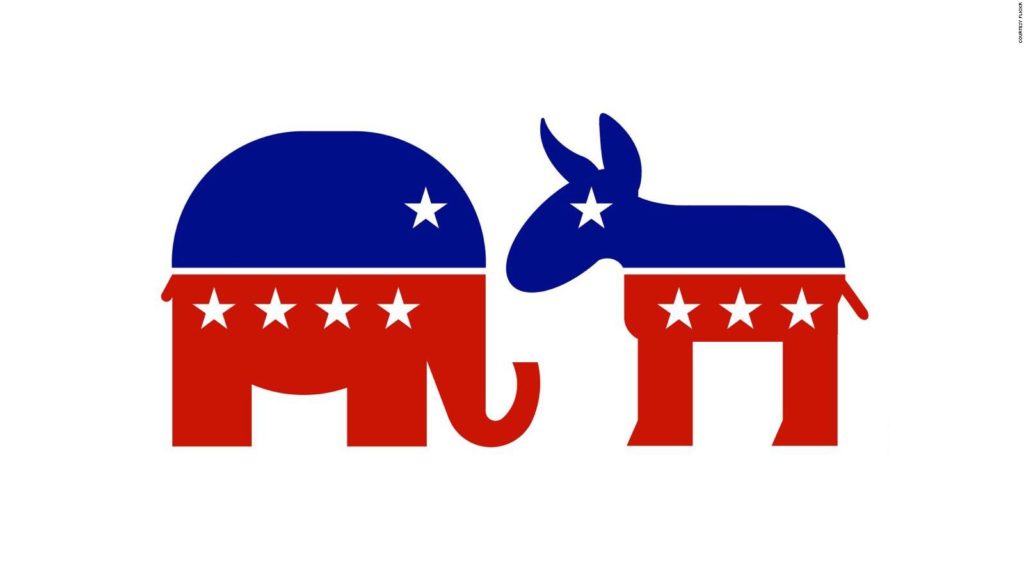Elephants and donkeys; a president who got stuck in the bathtub; and some great political cartoons…
Table of Contents
FICTIONAL ELECTIONS
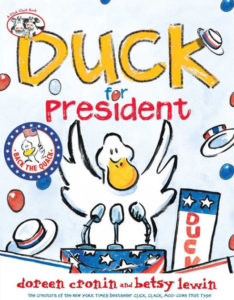
|
By Doreen Cronin and Betsy Lewin, Duck for President (Atheneum Books for Young Readers, 2004) is a clever and hilarious take on the political process. Duck is unhappy with his assigned chores on the farm (take out the trash, mow the lawn, grind the coffee beans), so he decides to hold an election and run for farmer. He beats the incumbent Farmer Brown; then finds that running a farm is hard work, so – in best Peter Principle fashion – he decides to run for governor, then president. (His campaign motto: “Duck, making us proud again.”) Executive office, however, also proves too taxing, and when Duck discovers that Farmer Brown is now advertising for a duck, he turns the Oval Office over to the vice president and returns to the farm. A hoot for ages 4 and up. |
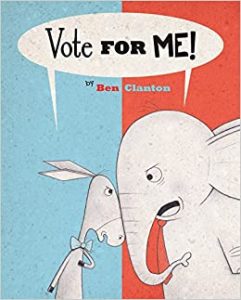
|
The cover of Ben Clanton’s Vote for Me! (Kids Can Press, 2012) has a glaring Donkey on the blue half of the page and a hostile Elephant on the red, which sets the stage for the rest of the action: the respective candidates bicker, bellow, call each other names, and offer shameless bribes to the electorate (PEANUTS! CANDY!). The outcome: independent candidate Mouse swoops in and wins the day. It’s a fun (but sobering) take on political discourse for ages 4 and up. |
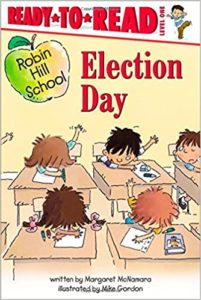
|
Election Day (Simon Spotlight, 2004) in Margaret McNamara’s Robin Hill School Ready-to-Read series features a classroom election. Kid candidates make grand campaign promises – a candy machine, no homework, a six-month summer vacation – until Becky takes a turn, explaining sensibly that she can’t guarantee spectacular treats, but that she’ll do her best. Guess who wins? (After, that is, the everybody-cover-your-eyes secret vote.) For ages 4-6. |
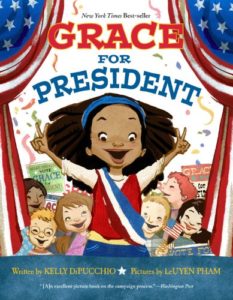
|
In Kelly S. DiPucchio’s Grace for President (Hyperion Books for Children, 2012), when teacher Mrs. Barrington rolls out a poster of presidential portraits, Grace Campbell is appalled: “WHERE ARE THE GIRLS?” Upset, Grace decides to run for president – and her teacher helps by organizing an election in which the kids in the class represent different states with their varying complements of electoral college votes. For ages 5-8. |
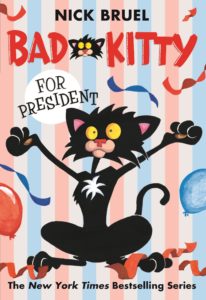
|
Nick Bruel’s Bad Kitty books are hilarious graphic novels, with black-and-white illustrations and interpolated nonfictional explanations of the action (from Uncle Murray, owner of the hapless Poor Puppy). In Bad Kitty for President (Square Fish, 2012), readers learn about elections as Bad Kitty competes to be president of the Neighborhood Cat Coalition. For ages 7 and up. |
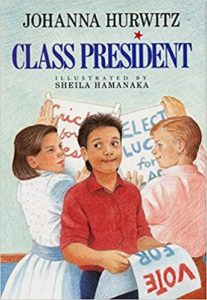
|
In Johanna Hurwitz’s Class President (HarperCollins, 1990), the fifth grade is electing a president. The main contenders are class clown Lucas and teacher’s pet Cricket (characters featured in Hurwitz’s earlier books), but Julio, Lucas’s generous, upright, and responsible campaign manager, seems more suited for the job. A chapter book for ages 7-10. |
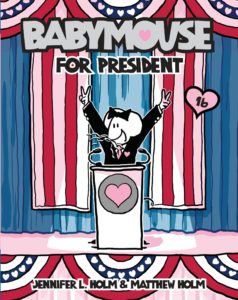
|
In Jennifer Holm and Matthew Holm’s Babymouse for President (Random House, 2012), Babymouse – the endearing mouse “with messy whiskers and a complete inability to remember her gym sneakers” – is running for president on a platform of a cupcake in every locker. She’s up against Felicia Furrypaws and her notorious mean-girl coalition. This is one of the popular Babymouse graphic novel series (in black, white, and pink) for ages 7-11. |
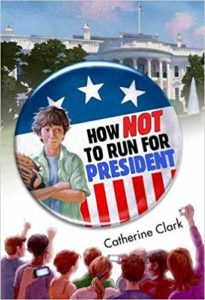
|
In Catherine Clark’s How Not to Run for President (Egmont USA, 2011), twelve-year-old clarinet player Aidan Schroeckenbauer saves presidential candidate Bettina Brandon (of the Fresh Idea Party) from a plummeting sign at a rally and ends up adopted by her campaign. The book is a catchy take on the election process, as Aidan copes with dirty politics and invasive media – and with Brandon’s daughter Emma, who can’t stand him. For ages 8-12. |
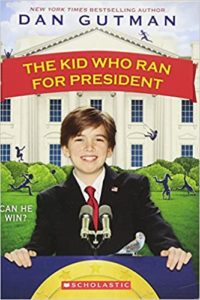
|
The star of Dan Gutman’s The Kid Who Ran for President (Scholastic Paperbacks, 2012) is 12-year-old Judson Moon, who decides to run for president in the 2000 election. He and best friend/campaign manager Lane Brainard found the Lemonade Party, recruit June Syers, Judson’s elderly African-American ex-babysitter as vice presidential running mate, and make it all the way to the debates on national TV. Amazingly, he wins the election (voters love him) – though Judson ultimately turns down the presidency, feeling that he’s bitten off more than he can chew. It’s funny, but there’s food for discussion here too: why, for example, do you have to be at least 35 to run for president? And why would adults vote for a kid? For ages 8-11. |
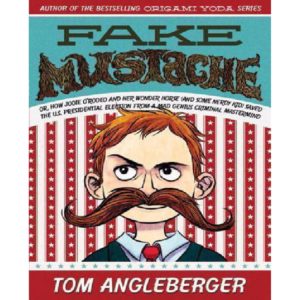
|
Tom Angleberger’s thoroughly goofy Fake Mustache (Amulet Books, 2012), subtitled “Or, How Jodie O’Rodeo and Her Wonder Horse (and Some Nerdy Kid) Saved the U.S. Presidental Election from a Mad Genius Criminal Mastermind,” features seventh-grader Lenny Flem Jr. and his friend Casper, who gets a gift of $400 from his nana Nookums and uses it to buy an impressive and expensive fake mustache (a Heidelberg Handlebar Number Seven) and a man-about-town suit. Thus disguised, Casper embarks on a career of bank-robbing (lifting billions), with the goal of becoming President of the United States and taking over the world. Only Lenny (the nerdy kid of the title) and Jodie O’Rodeo, a TV teenage singing cowgirl, are immune to Casper’s mesmerizing appeal, and it’s up to them to foil his dastardly plot. For ages 9-12. |
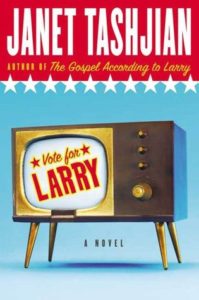
|
Janet Tashjian’s footnote-spotted Vote for Larry (Square Fish, 2008) is told in the first person by 17-year-old prodigy Josh Swenson, whose virtual alter ego Larry plans to reform politics by running for the presidency. Mystery, romance, idealism, and a lot of political facts for ages 14 and up. Also by Tashjian featuring Josh/Larry: The Gospel According to Larry (2004) and Larry and the Meaning of Life (2008). |
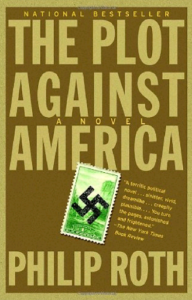
|
Philip Roth’s The Plot Against America (HMH, 2004) is an alternative history in which Franklin Roosevelt is defeated in the election of 1940 by Charles Lindbergh, a Hitler sympathizer, under whom anti-Semitism runs rampant. For teens and adults. |
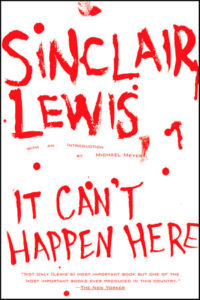
|
Sinclair Lewis’s It Can’t Happen Here (Signet, 2014), originally published in 1935, is a cautionary tale about the fragility of democracy. Buzz Windrip, a jingoistic demagogue, has been elected to the presidency, promising to bring prosperity and greatness, but instead establishing an authoritarian state. In opposition is small-town Vermont newspaper editor Doremus Jessup. An important and timely read for teens and adults. |
